
Mackerel is a common name applied to a number of different species of pelagic fish, mostly from the family Scombridae. They are found in both temperate and tropical seas, mostly living along the coast or offshore in the oceanic environment.

Carpet sharks are sharks classified in the order Orectolobiformes. Sometimes the common name "carpet shark" is used interchangeably with "wobbegong", which is the common name of sharks in the family Orectolobidae. Carpet sharks have five gill slits, two spineless dorsal fins, and a small mouth that does not extend past the eyes. Many species have barbels.
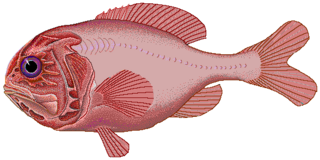
Slimeheads, also known as roughies and redfish, are mostly small, exceptionally long-lived, deep-sea beryciform fish constituting the family Trachichthyidae. Found in temperate to tropical waters of the Atlantic, Indian, and Pacific Oceans, the family comprises about 50 species in eight genera. Slimeheads are named for the network of muciferous canals riddling their heads.
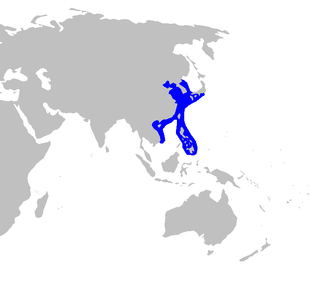
The Japanese spurdog is a dogfish, a member of the family Squalidae. It is found in the western Pacific Ocean – southeastern Japan and the East China Sea, including the Republic of Korea, the Philippines, and the Arafura Sea.
Ateleopus is a genus of ray-finned fish in the jellynose family Ateleopodidae. It is the type genus of its family, and the order Ateleopodiformes. For some time, it was known as Podateles, because Ateleopus had been used to replace the frog genus name Atelopus, which was deemed to be a spelling error. This was mistaken, however, and the fish and frog genera reverted to their original names.
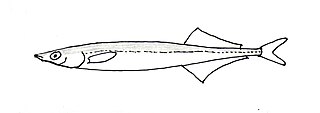
The Korean sandlance is a species of marine ray-finned fish belonging to the family Hypoptychidae. The Korean sandlance is the only species in this monotypic family and genus and is found in the northwestern Pacific Ocean.

An anchovy is a small, common forage fish of the family Engraulidae. Most species are found in marine waters, but several will enter brackish water, and some in South America are restricted to fresh water.
G. darwinii may refer to:
Enneapterygius philippinus, the minute triplefin, is a species of triplefin blenny in the genus Enneapterygius. It was described by Wilhelm Peters in 1868. This species occurs in the Indo-Pacific from Christmas Island to Samoa, and from the Ryukyu Islands in the north south to Australia.

Hoplostethus is a genus of fish in the slimehead family.
Aulichthys is a monospecific genus of marine ray-finned fish belonging to the family Aulorhynchidae. Its only species is Aulichthys japonicus, the tubenose, which is found in the shallow waters on the coasts of Japan, China and the Korean Peninsula This species lays its eggs inside of the peribranchial cavities of ascidians. This species grows to a length of 12.8 centimetres (5.0 in) SL.
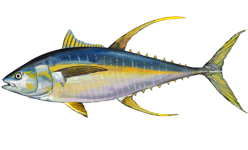
Thunnus (Neothunnus) is a subgenus of ray-finned bony fishes in the Thunnini, or tuna, tribe. More specifically, Neothunnus is a subgenus of the genus Thunnus, also known as the "true tunas". Neothunnus is sometimes referred to as the yellowfin group, and comprises three species:

Thunnus (Thunnus) is a subgenus of ray-finned bony fishes in the Thunnini, or tuna, tribe. More specifically, Thunnus (Thunnus) is a subgenus of the genus Thunnus, also known as the "true tunas". Thunnus (Thunnus) is sometimes referred to as the bluefin group and comprises five species:

Gymnapogon is a genus of fish in the family Apogonidae. They are native to the Indo-West Pacific and central Pacific Oceans, where they occur in reefs and nearby habitat types. These species are usually no more than 5 centimeters long and have semitransparent bodies without scales. The genus name is a compound noun formed by combining the Greek gymnos meaning "naked", referring to the lack of scales in the type species, Gymnapogon japonicus, and Apogon, the type genus of the Apogonidae. One species, the B-spot cardinalfish, is notable for its larvae being rather large, conspicuous and fast-swimming.

Pseudocaranx is a genus of ray-finned fishes from the family Carangidae, the jacks, trevallies, scads, and pompanos. They occur in the western Atlantic Ocean and the Indo-Pacific.
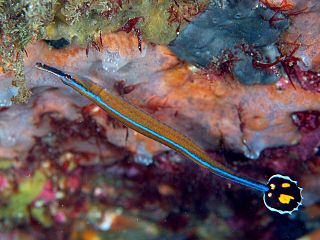
Doryrhamphus japonicus, or the Honshu pipefish, is a species of flagtail pipefish from the genus Doryrhamphus that occurs in the Western Pacific Ocean, from Milne Bay, Papua New Guinea, to Sulawesi, Indonesia, the Philippines, and north as far as Honshu, Japan and Korea. It is a marine demersal pipefish that inhabits coastal lagoons, rocky and coral reefs, and tidal pools down to as deep as 30 metres (98 ft) but it is unusual below 10 metres (33 ft). This species is frequently found in association with sea urchins of the genus Diadema and with sponges. It is an active cleaner, feeding on parasites found on other fishes. It frequently shares crevices with shrimps, large mud crabs and occasionally moray eels.

Gephyroberyx japonicus, the big roughy or blueberry roughy, is a species of fish in the family Trachichthyidae. It is endemic to the northwest Pacific off Japan, Taiwan and Hawaii, and can be found at depths between 300 and 1,500 m (980–4,920 ft). It can reach 30–35 cm (12–14 in) in length. Based on broadly overlapping morphological features it is sometimes considered a synonym of G. darwinii.

Gephyroberyx darwinii, the big roughy or Darwin's slimehead, is a species of fish in the slimehead family found widely in the Atlantic and Indo-Pacific oceans. This deep-sea species reaches a length of 60 cm (2.0 ft) and is mainly found at depths of 200 to 500 m (660–1,640 ft), but has been recorded between 9 and 1,210 m (30–3,970 ft). Based on broadly overlapping morphological features it sometimes includes G. japonicus as a synonym.
The Western Pacific roughy is a species of slimehead found in the Northwest Pacific along Japan's southern coast in Sagami Bay, Suruga Bay, and the Sea of Japan. It can reach up to 12.6 cm (5.0 in) SL and its depth range is 336–605 m (1,102–1,985 ft).














